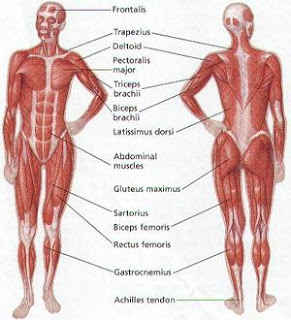The systemic Anatomy has been divided into two
classes:
(I) According to the headings of different terms employed
to indicate the knowledge of certain parts.
Examples:
Osteology is the knowledge of bones
Arthrology tells about joints.
Myology deals with muscles.
Splanchnology tells about organs or viscera.
Neurology discusses about nerves and nerve structure.
(II) According to the functions, they are grouped as
following:
- The locomotor system
- The blood vascular system
- The digestive system
- The respiratory system
- The ductless glands
- The urogenital system
- The nervous system
- The special sense organs
- The excretory system
1. The Locomotor System:
It includes the parts
concerned with the movement of the body. It has three basic components:
(a) Skeletal
system:
Consisting of bones, certain cartilages and membranes.
(b) Articulatory
system:
Which deals with joints or articulation.
(c) Mascular
system:
Includes muscles, fascia and tendon sheaths.
2. The Blood Vascular System:
It includes Circulatory
System and Lymphatic System. The blood is pumped round the body by heart,
oxygen is brought from the lungs and carbon dioxide is collected from the
tissues. The food passes to the liver and then to general circulation and waste
products are passed to kidneys.
3. The Digestive System:
It consists of alimentary
canal and glands and organs associated with it. The food is broken down by enzymes
in digestive tract and is taken by blood to liver and from there it is finally
taken to the tissues.
4. The Respiratory System:
It contains passage and
organs concerned with breathing, the oxygen from air is taken into blood and
carried to the tissues. The waste product carbon dioxide is carried by the
blood from body tissues to the lungs and breaths-out in expired air.
5. The Ductless Glands:
They are grouped together
because of the internal secretions which they produce. The spleen is included
sometimes in this group because it also has no duct, though it does not produce
an internal secretion.
6. The Urogenital System:
It includes organs of the urinary system and reproductive system. The waste products of the body except
carbon dioxide are excreted by kidneys.
7. The Nervous System:
It is composed of central
nervous system which includes brain and the spinal cord. It also has peripheral
nervous system consisting of the nerves given of from brain and spinal
cord.
The autonomic nervous system includes sympathetic
and parasympathetic
nerves. It is also known as involuntary nervous system. The central and
peripheral systems are often grouped together and are called as Cerebrospinal
Nervous System.
8. The Special Sense Organs:
The taste, smell, sight,
hearing and tactile functions of skin are discussed here. It is through theses
organs that the individual is kept aware of the external forces and thus
protects himself.
9. The Excretory System:
It is a term sometimes
employed to describe collectively the organs that deal with the excretion of
waste products from the body. It includes urinary system, the lungs for
elimination of carbon dioxide and colon which excretes certain insoluble
substances in faeces.














0 Comments